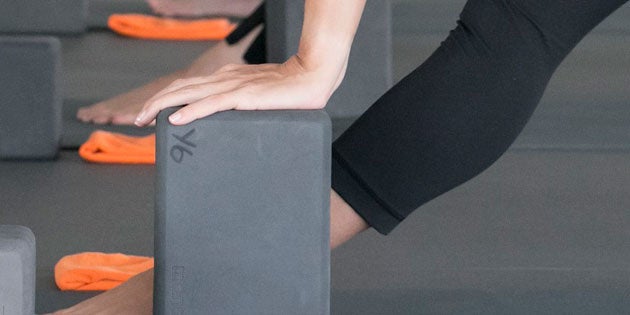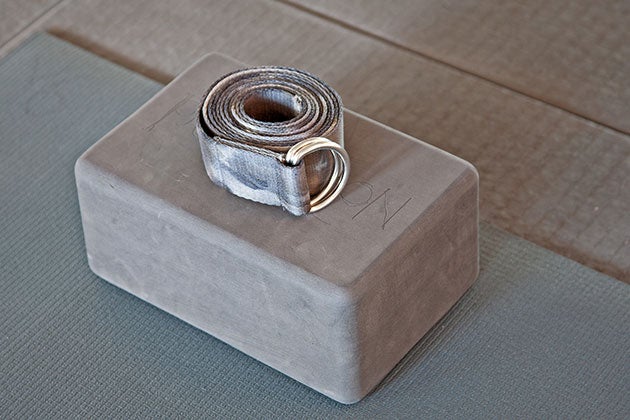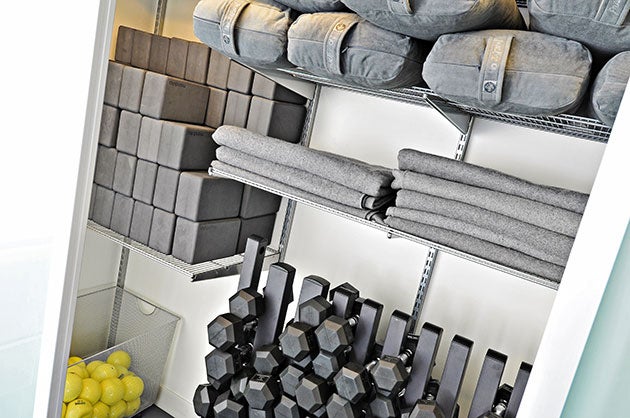Heading out the door? Read this article on the new Outside+ app available now on iOS devices for members! Download the app.

Let’s get one thing straight: Yoga props are not just for newbs.
But to most women, especially those who are accustomed to pushing themselves in the gym and, let’s face it, are pretty competitive with both themselves and others, yoga props are just a way to make poses easier.
“Most women view yoga props as a crutch,” says former competitive gymnast and current Yoga Six instructor and vice president of marketing Laurenn Cutshaw. “They have ideas about what poses ‘should look like,’ either from images they see online or from other students, and getting into the pose becomes their primary goal.” What’s more, most studios and teachers don’t educate students on proper usage and benefits of props, so they seem like an extra students shouldn’t need.
That approach is flat-out wrong. “Props aren’t meant to make poses easier,” she says. “They exist to keep students in proper alignment, no matter their experience or skill.” Every body is unique in its anatomy, including bone lengths, joint depths and sites of muscle attachment. Down dog is mechanically different for you than it is for any other woman. And getting into a position that’s meant for someone with a shorter torso or greater range of motion in the shoulder throws off alignment, or body positioning, thereby risking results and injury, Cutshaw says. However, by not using props, that’s exactly what far too many women do.
Think of it this way: You wouldn’t dare perform squats or walking lunges with incorrect form. So why would reaching your toes without a block merit incorrect form during yoga?
What’s more, on the mental side of things, forcing yourself into positions designed for another woman’s anatomy is altogether frustrating. “Admiring another student’s practice or aspiring to achieve things they have is great,” Cutshaw says. “Comparison, on the other hand, kills personal progression and is the antithesis of a yoga mindset. The focus in yoga needs to be on the practitioner’s internal world. How do I feel today? How does this movement feel in my body? How is my breath? What, if anything, is different today?”
It doesn’t matter if you use a prop during a seated forward bend and the woman next to you doesn’t. As long as both of you are in correct alignment, you are both rocking a perfect seated forward bend.
Your move: If you feel pain, strain or your form slipping while trying to get into a pose, make use of these three yoga props. Your instructor will be able to supply them and show you how to properly use them, while you can also purchase them online from various retailers for your at-home practice.
Blocks
In poses like triangle, forward fold and runner’s lunge, these rectangles, which come in both foam and cork, “elevate the floor” to allow students with tight hamstrings and short arms alike to reach the floor without compromising body positioning, Cutshaw says. What’s more, they can actually be used to increase muscle engagement and help you get more muscle-building benefits from your practice. “Any time you place and hold a block between your legs, like in camel, bridge or mountain, you can better tap into the adductor muscles,” she says. “The block requires the student to hug in toward the midline and lengthen the tailbone toward the floor.”

Straps
Use these any time you need to “extend a limb.” For example, in a posture that requires a bind, clasping the hands together behind the body and around a leg, a strap can help being the hands closer to each other. In dancer, using a strap can allow you to reach the foot without wobbling or straining joints in the case of limited hip or shoulder mobility, she says.
Bolsters
The benefits of bolsters are more or less the same as those of blocks and straps. However, bolsters (essentially pillows) are typically used in different circumstances. For instance, while sitting on a block is OK for a few breaths, if you’re going to hang out on a prop for any longer, a bolster is a more comfortable option, says Cutshaw. She notes that bolsters are often used during slower, restorative styles of yoga. In these classes, bolsters are critical to opening body parts, supporting others and aiding in muscle release.
